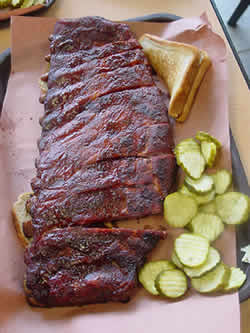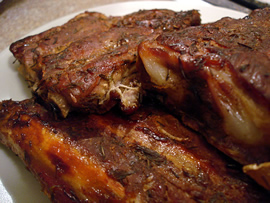Difference between Beef Ribs and Pork Ribs
Key Difference: Beef ribs and pork ribs are a cut of meat. Beef ribs are derived from cow's rib cage, whereas pork ribs are derived from a pig's rib cage. Beef ribs are quite bigger than pork ribs. Therefore, beef ribs tend to have more meat than pork ribs and are typically more chewy than pork spare ribs.
 Ribs of beef or pork refer to a cut of meat. Beef ribs are derived from cows, whereas pork ribs are obtained from pigs. It usually refers to the part of chops which is less meaty. These ribs can be made to cook by using a variety of techniques like roasting, grilling, baking, etc. However, in American cuisine, these ribs usually refer to barbecued ribs which are often served with any of the barbecue sauces.
Ribs of beef or pork refer to a cut of meat. Beef ribs are derived from cows, whereas pork ribs are obtained from pigs. It usually refers to the part of chops which is less meaty. These ribs can be made to cook by using a variety of techniques like roasting, grilling, baking, etc. However, in American cuisine, these ribs usually refer to barbecued ribs which are often served with any of the barbecue sauces.
Beef ribs are basically of two types – back ribs and short ribs. In back ribs the meat lies between the bones. On the other hand, in short ribs the meat lies on the top of the bones. Short ribs are named after the short plate from which they are derived.
Beef ribs are usually less expensive than pork ribs. Beef ribs contain massive bones and are not much meaty.
 Pork ribs are very popular types of ribs throughout the US south and are derived from the pigs. Pigs have 14 rib bones. These rib bones are divided into four popular cuts known as baby back ribs, spareribs, rib tips and St. Louis cut. Baby back ribs are derived from the blade and center section of the loin.
Pork ribs are very popular types of ribs throughout the US south and are derived from the pigs. Pigs have 14 rib bones. These rib bones are divided into four popular cuts known as baby back ribs, spareribs, rib tips and St. Louis cut. Baby back ribs are derived from the blade and center section of the loin.
Spare ribs are the intact rib section separated from the belly and may also include coastal cartilages. St. Louis style ribs originate from pork spare ribs are are prepared by removing brisket bone. Rib tips are smaller meaty pieces which are cut from pork spare ribs when St. Louis ribs are being made by applying a trimming process. These ribs are smaller and easy to handle. In terms of nutritional values, both pork and beef ribs are quiet the same. Beef ribs are typically chewier than pork ribs.
Beef ribs have less fat than pork ribs. Due to this fat present in pork ribs they do not require much attention to be kept moist and tender as required by beef ribs. Beef ribs must be cooked slowly at a low temperature so that the connective tissues melt properly. Beef ribs are cooked best in a smoker. American barbecue beef ribs aren't nearly as common as their porky counterparts.
Beef ribs are quite huge as compared to pork ribs. It still depends upon the individual's choice to prefer one over the other as both are different in texture and taste.
Comparison between Beef Ribs and Pork Ribs:
|
|
Beef Ribs |
Pork Ribs |
|
Definition |
Beef ribs are derived from the rib cage of cows |
Pork ribs are derived from the rib cage of pigs |
|
Type |
Big and not very easy to handle |
Small and easy to handle |
|
Content (4 ounces) Roasted |
Beef ribs (shortribs) 340 calories, no carbohydrates, over 35 grams of protein, 27 milligrams of calcium, and 328 milligrams of potassium, 20 grams of total fat, and 105 milligrams of cholesterol. |
Country style ribs (pork) has 320 calories, 30 grams of protein, 34 milligrams of calcium, 340 milligrams of potassium, 20 grams of total fat, and 115 milligrams of cholesterol. |
|
Moist and tender |
More effort required |
Less effort required |
|
Common types |
|
|
|
Texture |
|
|
Images Courtesy: whatsyourtemperature.com









Comments
Robert G
Sun, 09/24/2017 - 03:02
Hi Robert, thank you for pointing out these errors. We have gone over the article and fixed them.
dbadmin
Mon, 09/25/2017 - 10:16
Add new comment